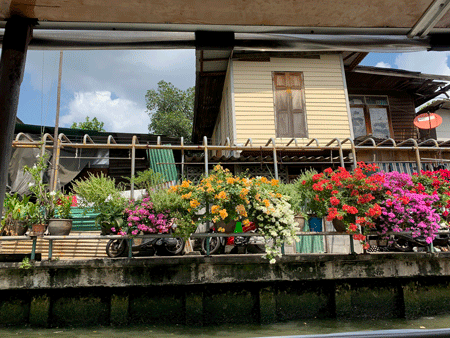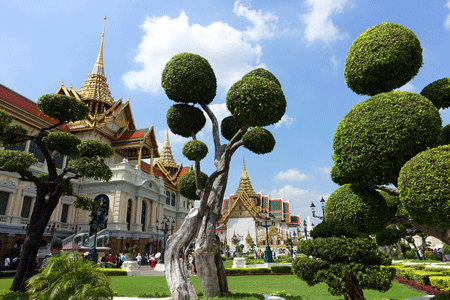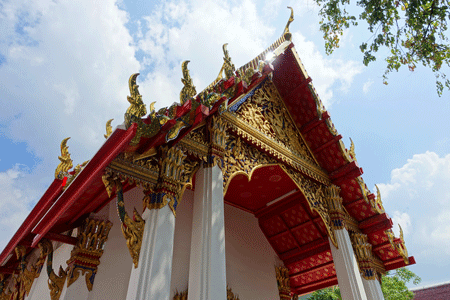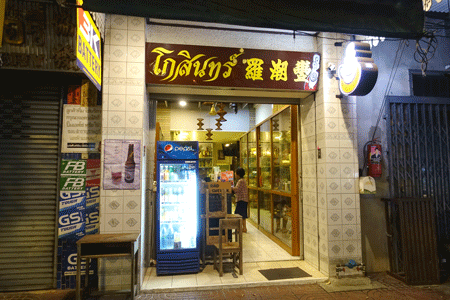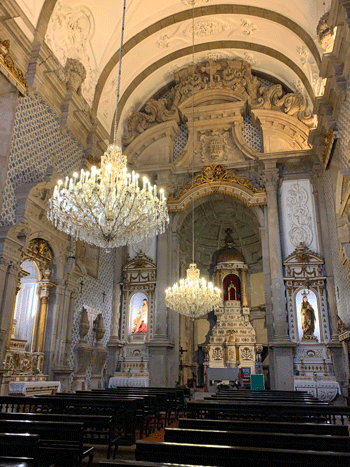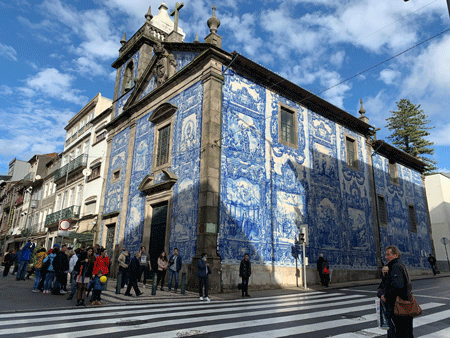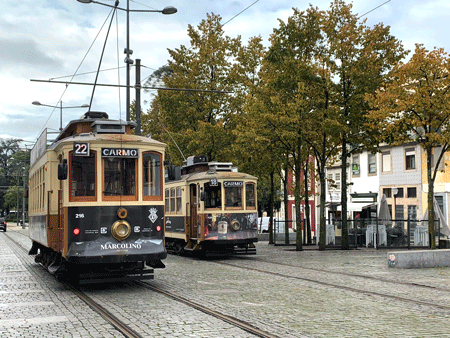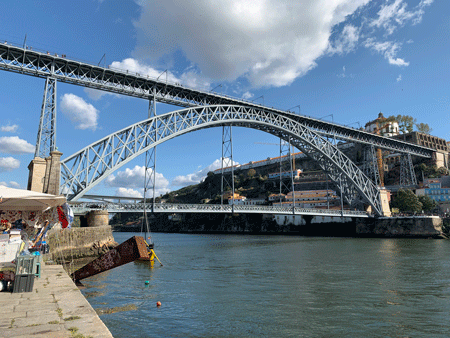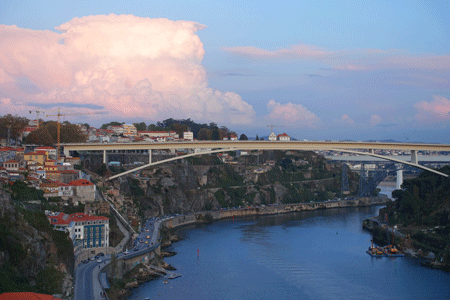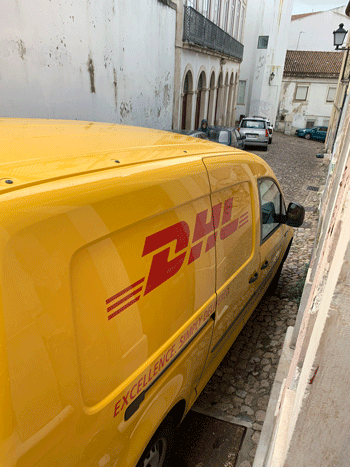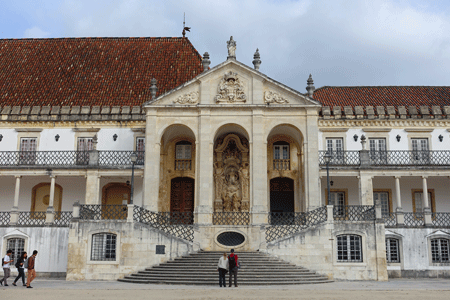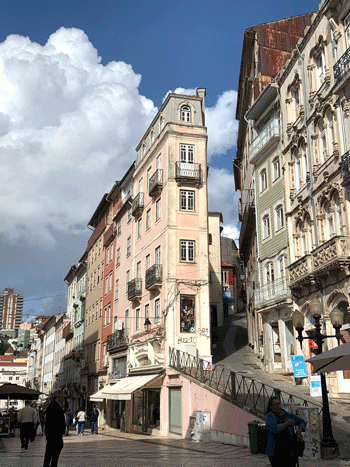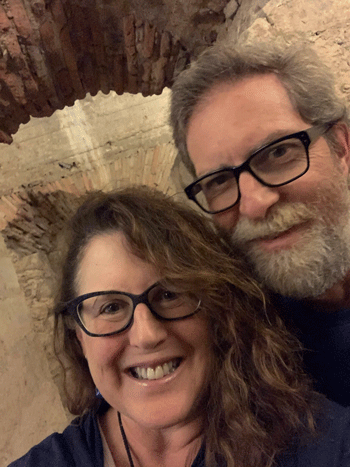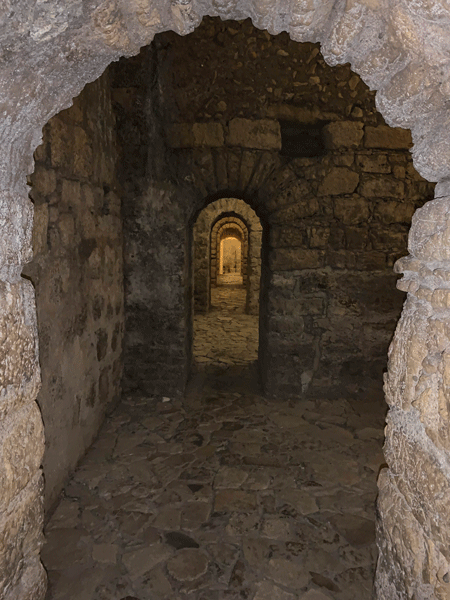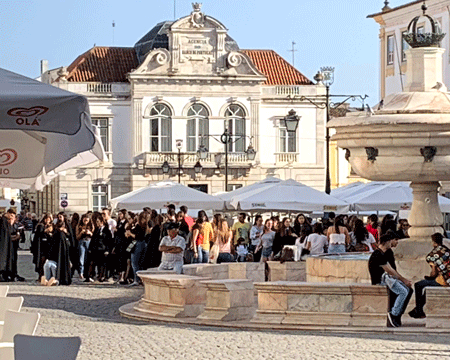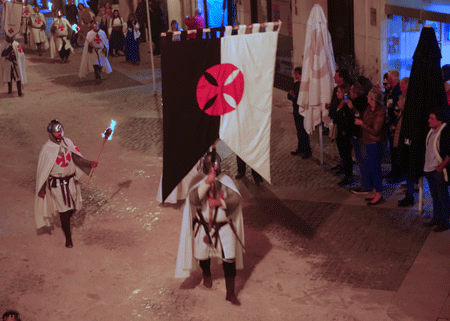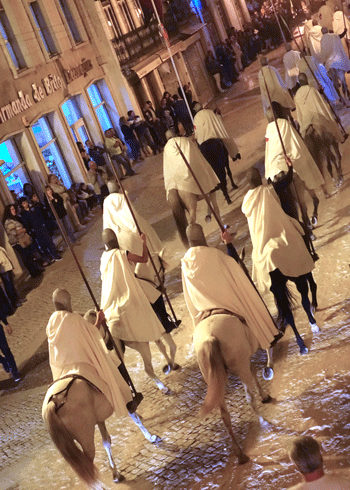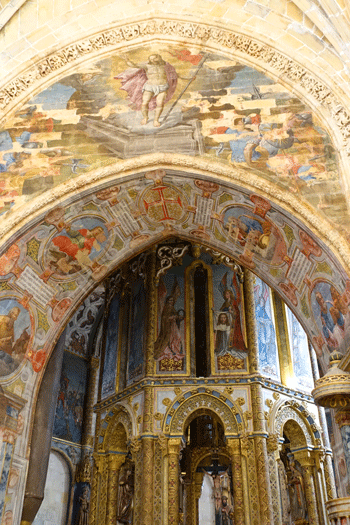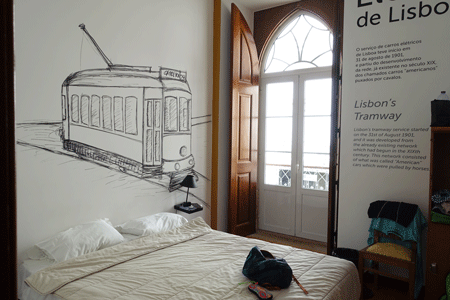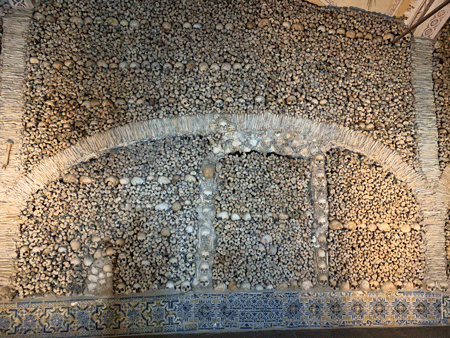(By No Means a Comprehensive List)
Posted October 31, 2019
Walk Around a Bit


We typically do a ton of walking when we’re in a new city. The guidebooks say that Bangkok isn’t very pedestrian friendly, but I found that besides crossing the street (see “The Game Changer” post), you can and should walk around a bit while here.

to and over the street
Just a couple of minutes from our guesthouse, we came across a stunning park with manicured gardens, bright flowers, and amazing structures.
The major streets typically have a center island with a gigantic, ornately framed picture of the King, along with beautiful flower beds that are in perfect condition.

It’s funny to watch as dozens of motorcycles weave their way through thick traffic at every red light so they can gain that little edge, then take off as quickly as possible at the green.
Google Map It
When planning our day, we google map our planned destination and, if google says it’s under a 20 minute walk, we go for it. The shorter the distance the better, because it is consistently very hot and humid.

Unfortunately, more often than I’d like, we end up walking longer than planned, and I end up a sweaty, dragging mess of a tourist.
Thankfully, if this happens, there’s always an air-conditioned taxi or a open-air tuk tuk ride with our name on it just around the corner.
Explore the Klongs
Take a local river taxi and explore the Klongs (canals) that meander through the city. It’s a little tricky to find where to board the boats. What worked for us was to follow along a canal until we saw stairs going down to the water level. At every set of stairs to a pier there was a bustle of activity with lots of locals going up and down. Once we knew what to look for, it was much easier to find a pier.
There are lots of options to explore the Klongs. The river taxi, used by locals, costs between 9 and 19 baht depending on the distance (.30 cents to .49 cents), but barely stops at each pier. Customers must have their head “in the game” and leap on and off as the taxi slows at each pier. You snooze, you lose.
River Taxi Express
We chose the River Taxi Express service, which is geared more to tourists. It costs significantly more (around $6), but allows easier on and off loading. One price and we had unlimited hop-on and hop-off up and down one canal for the entire day. Now that we know how it all works, I think the regular river taxi would have worked just fine for us. Whichever you choose, just get out on a canal for a fascinating look at Thai life.
Visit Wats

Our first full day in Bangkok we visited the Grand Palace, Wat Pho, and Wat Arun. These are the three big tourist sites in Bangkok, the “must-see” attractions.
All the sites are sprawling complexes, that include the Wat (temple), and Stupas (dome-shaped structures erected as Buddhist shrines), and other assorted buildings. The Grand Palace takes the prize for biggest, but not necessarily best. Each temple is unique and absolutely worth visiting.
The Grand Palace
The Grand Palace is the one attraction that absolutely everyone goes to (or so it seems). It is incredibly crowded. It opens at 8:30 am, and it seems the best bet to avoid crowds is to arrive as close to opening as possible.
Wat Pho
Wat Pho’s main feature is a reclining Buddha built by Rama III in 1832. The Buddha is 150 feet long and 50 feet high, covered in gold leaf. To say it’s an impressive sight is an understatement. But don’t just go to see this Buddha, there is a huge complex full of incredible sites.

Head of reclining Buddha at Wat Pho 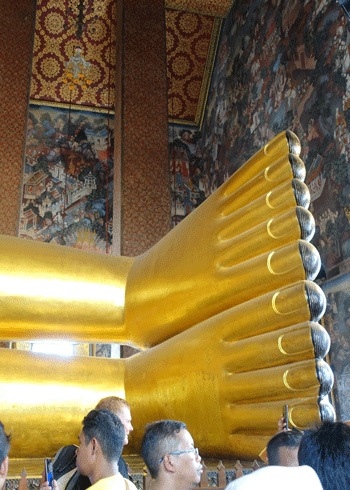
Feet end
Wat Arun
Wat Arun is across the river from the other two sites, so Kobkul, our guesthouse host, told us to take the river taxi. She explained where to catch the river taxi, but neither Steve nor I could remember the name of the Pier.
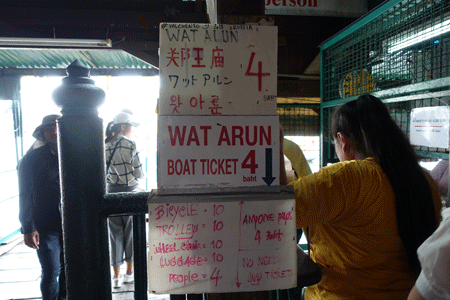
4 Baht to Cross the River 
Ferry across the river with picture of the King
Somehow lady luck was on our side and we walked from Wat Pho for about 20 hot and sweaty minutes in the general direction of where we thought the Pier was. We arrived at the correct Pier, and were thrilled (to stop walking in the heat). We paid the 4 baht each (about .13 cents) and rode across the river.

Eat Street Food
The Metro

metro stop. Geez.
Kobkul, our Thai host, told us the best street food in Bangkok is found in Chinatown. The street vendors start at 8 pm. Kobkul recommended we take the metro system, since Chinatown is pretty far from the house. I was curious to see what the metro was like, since all the above ground traffic is a bit chaotic and uncontrolled. To my surprise, the metro is very modern, sleek, orderly, and clean. Our tickets cost 28 baht, or .92 cents, each way. It was a fast, comfortable, and air-conditioned way to travel under the city.
The Throngs
Coming out of the Metro, we walked a ways, not sure which way to go. Finally we turned a corner and we were suddenly in the midst of a throng of people and street vendors. So much activity, flashing lights, and noise. Thousands of people were jammed on both sides of the street. People edged along as best they could, squeezed between the food vendors, each other, and the cars. We joined the crowds and walked along, a bit overwhelmed by all the people and food choices.

Incredible, mouth-watering aromas wafted over us, changing every 10 steps or so. Every vendor had their own kitchen set up and was cranking out their specialty to the waiting crowds. Many popular vendors had long lines of waiting fans. Vendors cooked noodles and stir-fries in large, blackened woks heated by big gas-fed flames. Satay skewers sizzled on large BBQ’s. Dipping sauces bubbled on the stove. Everywhere I looked the vendors were cooking and prepping.
Mouthwatering

Admittedly, there was a large percentage of food that we just couldn’t identify. We weren’t even sure if some foods were desserts or savory, so we tended to stick with what is familiar, pot stickers and a noodle dish. The pot stickers were the best ever. Crunchy and fried, but not greasy, with a very subtle hint of sweetness to the dough. And the noodle dish, with the thick, chewy noodles and spicy garlic sauce was spot on. Wow, so good.
Absorb the Local Flavor

We stayed four nights in a Thai guesthouse, with a local, in a typical Bangkok neighborhood. We had an authentic experience that we wouldn’t have had in a hotel. And we saved a ton of money too. We spent $28 a night, which included a wonderful Thai breakfast, tons of tips from our host, and some special and unexpected treats, like lotus flower seeds Kobkul found especially for us.
Our choice probably isn’t right for everyone, but I loved it.
Meeting Kobkul
It was such a pleasure getting to know Kobkul, our guesthouse owner. She’s lived in this home for four years, but in the neighborhood for forty. Her house, named “Air Raid Shelter 3” on the Airbnb website, is located at 74 Machachai Road, just across the street from a famous Pad Thai restaurant, Thipsamai (that is mentioned in every guidebook, but really is nothing special).
Breakfast at the Guesthouse

Breakfast is served each morning at 8:30 am down in Kobkul’s cafe on the ground level. It’s not what I would typically call a cafe, it’s more like a coffee stop. She has a nice espresso maker and refrigerated display case full of drinks, that faces out to the street front. She serves coffee and cold drinks to folks passing by.
For our breakfast, we sit at one of the two tiny round wooden tables she has for her guests. There’s only one proper size chair, which I seem to always grab first. Steve sits on a tiny stool to my left (sorry, dude).

Kobkul sets two Bento boxes down on the table in front of us, one each. Our meal consists of hot rice (white or stir-fry), a bit of meat (chicken or pork), sometimes some cucumbers or spices, and some kind of fruit or muffin for dessert. And every day there’s a tiny baggie filled with a delectable sauce, sometimes spicy, sometimes sweet. It’s fun opening your little baggie to see what sauce you have that morning. Kobkul makes great coffee (I get mine iced because it’s so dang hot out), and often provides something small and sweet to finish out the meal.
Just Eat It

and little muffins cooked in banana leaf
To be honest, we didn’t always know what Kobkul served us. One morning there was a dark blob of something in and among my rice, meat, and sauce, and I had no idea what it was. It was a chocolate brown color and had the consistency of a solid, non-shiny, chunk of jello.

I tried a couple of small bites. It didn’t have much flavor. I asked Kobkul what it was. She kind of laughed nervously and said I may not like it. She said it was from a chicken, then she pointed up and down to her inner forearm. I have no idea what she was trying to tell me, and I have to say I felt really uncomfortable about the brown blob after that. I’ve done an extensive google search to try to figure it out, to no avail. Suffice to say that Steve finished the brown blob for me so I didn’t offend Kobkul. Thanks, Steve, I owe you one.
Update: After consulting with my sister-in-law, Ina, who is Indonesian, it turns out the congealed chocolate brown mass was chicken blood. Hmmmm…so glad I didn’t finish that up. So interesting how different foods are customary in different cultures.
The Guesthouse Shower
The guesthouse bathroom was a first for us, an “all-in-one” set-up. An avocado green toilet and matching sink, along with bright green tiles and plastic green flooring, make up the small, square bathroom. What makes the bathroom unique (to us), was that the shower head was mounted on the wall above the toilet, a little to the left.
A Wet Room

When you shut the door, the entire room became the shower. It’s called a “wet room”. When showering, everything inside the bathroom gets soaked including the toilet, walls, and sink.
We shared the bathroom with two nice 20-something women from France, who were traveling in SE Asia for two months. I never knew when I was going to encounter a sopping wet bathroom, and sit on a drenched toilet (and I’m sure they felt the same way). It really wasn’t a problem once I got used to the idea – it was just water, after all.
Take Precautions
Speaking of water everywhere, there really should be a warning sign posted in bathrooms like this (for us novices), reminding us to set the toilet paper, the towel, and eyeglasses (if applicable) outside the shower before turning on the water. I only soaked one toilet paper roll that one time (during a shower), I promise.
The Mantra

Perhaps a delicate bathroom topic, but worth mentioning, is that we can’t flush TP down the toilet. I’ve encountered this same issue in Mexico a few times. The plumbing just can’t handle the paper, so it is what it is.
Every time I sat on the pot I’d repeat my mantra, “Don’t put TP in the toilet, don’t put TP in the toilet, don’t put TP in the toilet”, until my business was complete and the TP was securely in the garbage bin provided.
Steve Wins
I only had to fish out the TP twice in 4 days, when apparently my mind wandered from my mantra. Steve only had to fish out the TP once. Steve wins.
Spicy Food: Special Note

Do not touch your face after sprinkling hot chili on your food using bare fingers. It’s a bad idea, unless you like having a burning, stinging face for about 30 minutes.


